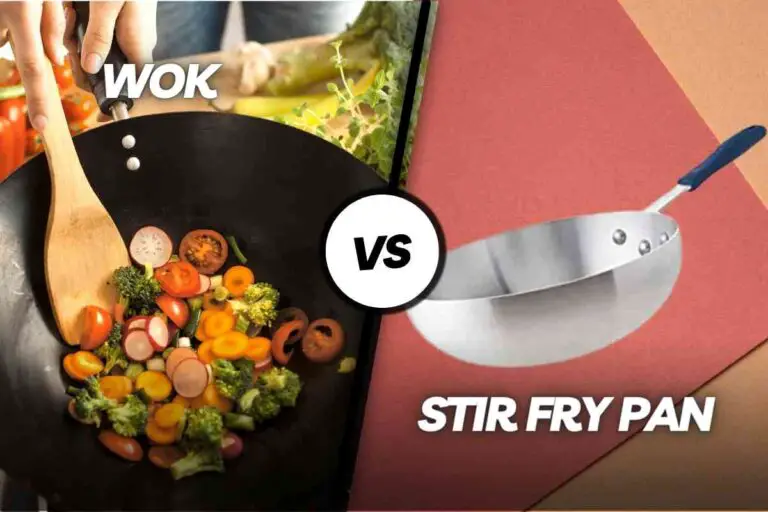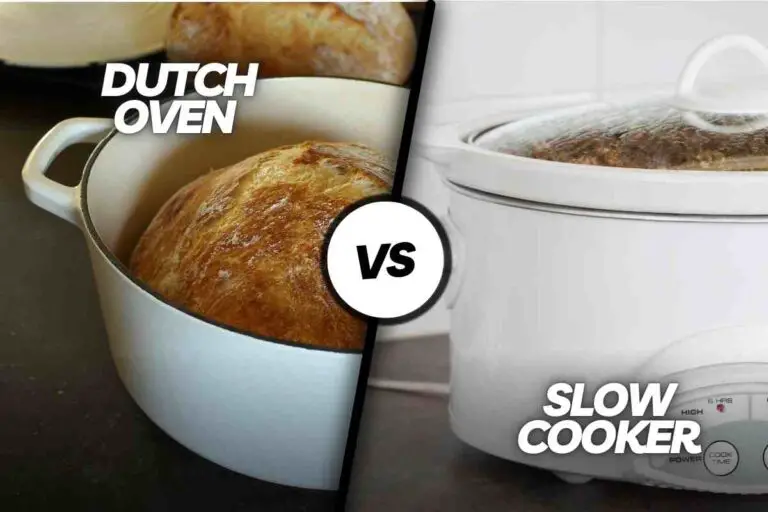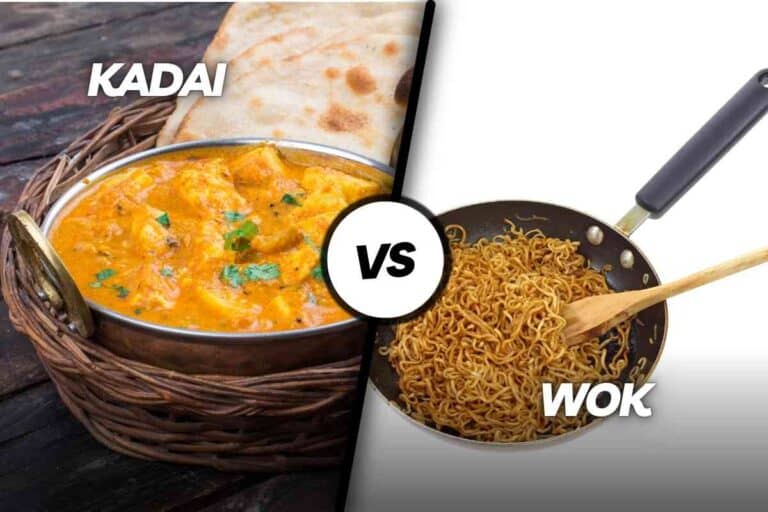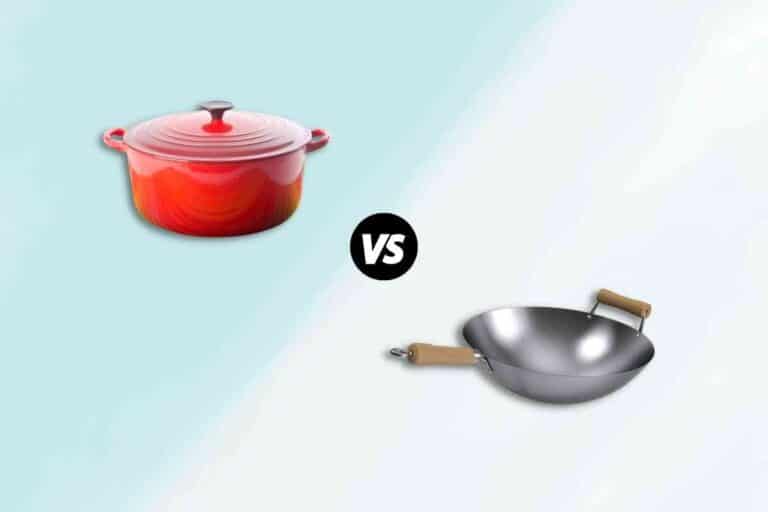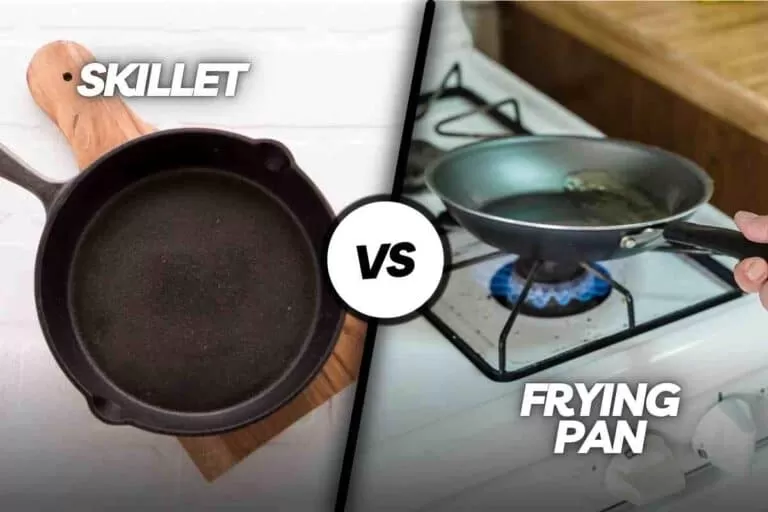6 Key Differences: Saucepan Vs Frying Pan
The main difference between saucepans and frying pans is their intended use and design. Saucepans are primarily used for tasks like making sauces, soups, and boiling water, with taller sides that hold volume upward. In contrast, frying pans are designed for frying chicken, meat, fish, and similar dishes, featuring shorter sides that hold volume outward.
These distinctions in purpose and design determine their suitability for various cooking applications.
When it comes to saucepans and frying pans, there are key differences to consider.
- Functionality: Saucepans are designed for simmering and boiling, making them ideal for tasks that require frequent stirring. On the other hand, frying pans are crafted for flipping and tossing, similar to how you’d handle a pancake or create an omelet.
- Design: Saucepans come in various sizes and materials, offering flexibility in your kitchen. In contrast, frying pans typically have a broad, flat shape.
- Price: If affordability is a priority, saucepans are generally more budget-friendly compared to frying pans.
Ultimately, the choice between a saucepan and a frying pan depends on your specific cooking needs and preferences. It’s all about finding the right fit for your culinary style and kitchen requirements.
Table About Differences Between Saucepan Vs Frying Pan
| Aspect | Saucepan | Frying Pan |
|---|---|---|
| Shape | Deep, round with a smaller surface area | Typically round with a wide base and handle |
| Materials | Metal, ceramic, glass, etc. | Mostly aluminum or stainless steel |
| Cooker Compatibility | Gas, electric, induction, etc. | Compatible with various cookers |
| Lid | Often comes with a lid to retain heat and prevent splatters | Typically lacks a lid |
| Cooking Purpose | Sauces, soups, even heat distribution | Frying, quick liquid evaporation |
| Using as a Substitute | Not recommended for tasks requiring liquid retention | Not ideal for certain liquid-heavy cooking tasks or even cooking |
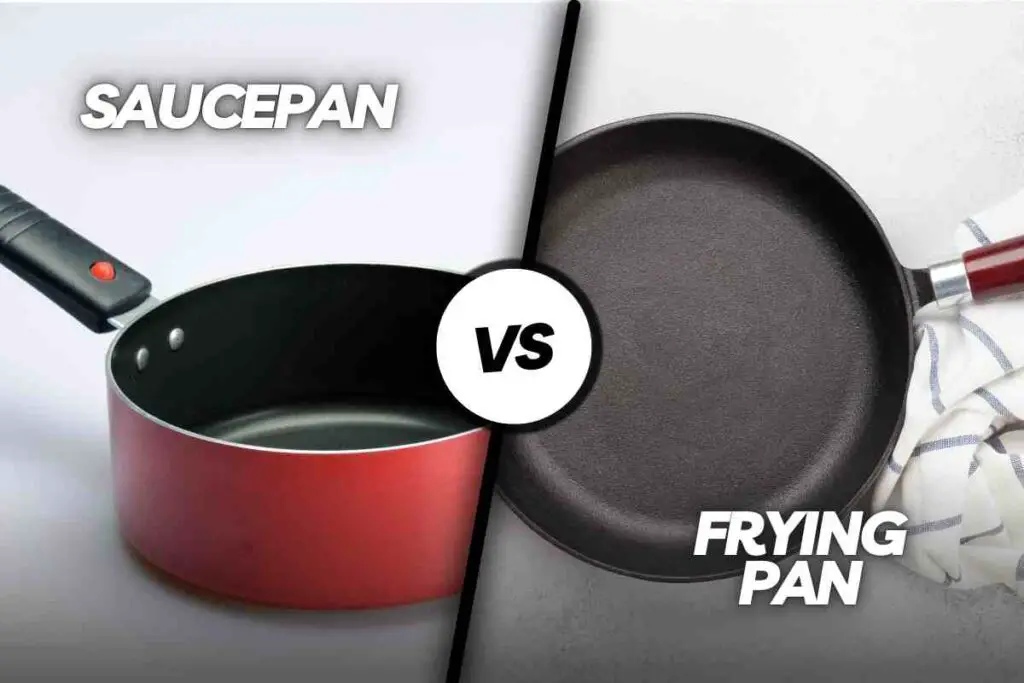
What is a Saucepan?
Let’s start with saucepans. Picture a deep, round pot with a smaller surface area. They come in various materials like metal, ceramic, and glass, making them versatile for different cooking needs.
Whether you have a gas stove, an electric one, or even an induction cooker, saucepans are your trusty companions in the kitchen.
One of the things that sets saucepans apart is their lids. Many saucepans come with lids, and these lids serve a purpose.
They help retain heat and prevent those annoying splatters when your sauce or soup decides to bubble enthusiastically.
Try AVACRAFT Tri-Ply Stainless Steel Saucepan.
Advantages of Saucepans
Saucepans bring some impressive advantages to your cooking game:
- Multipurpose Use: You can use saucepans for various tasks, from simmering sauces to boiling pasta. They’re versatile kitchen workhorses.
- Long Handles: They usually have long handles, making it easy to carry them around the kitchen without burning your hands.
- Even Heat Distribution: Saucepans are designed to distribute heat evenly, preventing hot spots that can lead to uneven cooking.
Disadvantages of Saucepans
While saucepans are great for many things, they do have their limitations:
- Accessing Food at the Bottom: The deep shape of saucepans can make it a bit tricky to reach food at the bottom, especially when you’re stirring or flipping.
- Not for Frying: If you’re planning to fry something, a saucepan might not be your best bet. Their design isn’t ideal for frying tasks.
What is a Frying Pan?
Now, let’s turn our attention to frying pans. You’ve probably used one of these before. Frying pans are typically round with a wide base and a handle that makes flipping and tossing a breeze.
They’re often made from materials like aluminum or stainless steel and come in various sizes and shapes, including oval and rectangular options.
Frying pans come in various sizes, from small pans that are only a few inches in diameter to large pans that are more than a foot wide.

Advantages of Frying Pans
Frying pans have some fantastic advantages:
- Versatility: They can handle a wide range of cooking tasks, from making pancakes to searing steak.
- Quick and Even Heating: Frying pans heat up rapidly and distribute heat evenly, ensuring your food cooks consistently.
- Ease of Use and Cleaning: Their design makes them easy to use, and cleaning up afterward is a breeze.
Disadvantages of Frying Pans
But like any kitchen tool, frying pans have their downsides too:
- Oil Splatter: Be prepared for some oil splatter, especially when frying at high temperatures.
- Sticking Issues: If you’re not careful, food can stick to the pan, leading to frustrating cooking experiences.
- Storage Challenges: Due to their size and shape, frying pans can be a bit tricky to store neatly in your kitchen cabinets.
What Are the Cooking Purposes of Saucepans and Frying Pans?
Now that we’ve covered the basics, let’s talk about when to use each of these kitchen heroes.
Cooking Purpose of Saucepans
Saucepans are your go-to choice for:
- Making delicious sauces that need to simmer and thicken.
- Crafting comforting soups that require liquid retention.
- Tasks where you need an even distribution of heat, like boiling eggs.
Cooking Purpose of Frying Pans
Frying pans shine when you’re:
- Frying chicken, fish, or any other food that needs a good sear.
- Cooking dishes that need rapid liquid evaporation, like stir-fries.
- Making breakfast classics like omelets or pancakes that require flipping and quick cooking.
Can I Use a Frying Pan as a Saucepan?
Sometimes, you might find yourself in a situation where you need a saucepan, but all you have is a frying pan.
Can you use a frying pan as a saucepan? Well, it’s not the best idea. Frying pans aren’t designed for tasks that require liquid retention or even cooking of certain foods.
If you find yourself in this situation often, consider investing in a pot with flared sides, which can be a suitable alternative to a saucepan.
Saucepan Vs Pot
A saucepan and a pot are similar kitchen utensils used for cooking, but there are some differences between them. A saucepan is usually smaller with a narrow base and high sides, used for boiling or simmering liquids, making sauces, or reheating food.
A pot, on the other hand, is larger with a wider base and lower sides, used for boiling, stewing, or braising food, or cooking soups, stews, and pasta.
Difference Between Saucepan and Frying Pan | Sauce Pan Vs Frying Pan
The difference between a frying pan vs sauce pan is that a saucepan has straight sides and a frying pan has sloped sides. A saucepan is also typically smaller than a frying pan.
The straight sides of a saucepan are good for cooking food that needs to be stirred, such as soup or rice. The sloped sides of a frying pan are good for cooking food that needs to be flipped, such as pancakes or eggs.
Stainless steel
When you are cooking, it is important to understand the difference between a frying pan and a saucepan.
While a frying pan is generally larger, a saucepan is deeper, and is designed to hold more liquid. Typically, saucepans have high sides, which indicate they are for stovetop use.
Stainless steel is a great choice for cooking over high heat, since it can handle high temperatures. It is ideal for searing and stir-frying.
However, it is important to remember that cooking with stainless steel can cause your food to stick to the pan. This can leave a black or dark brown residue.
Non-stick
When deciding between a Non-stick saucepan and a frying pan, you may be wondering which one is better.
There are a few differences between the two, including the size of the pan. Non-stick pans have multiple layers to help prevent food from sticking and releasing a lot of grease.
When cooking, you want to leave room between the pieces of food to prevent burning. If you crowd the pan too much, food will not brown properly.
Non-stick pans are typically made of aluminum with a coating of a non-stick material. Alternatively, non-stick pans can be made of PFOA-free Teflon or ceramic.
Lightweight pans are great for preparing healthy food, but heavier pans are better for distributing heat evenly. Some pans are also oven-friendly, which can be handy for baked eggs.
Enamel
One of the most significant differences between saucepans and frying pans is their size. Frying pans are usually much larger than saucepans and are not portable.
They also tend to be heavy and are more susceptible to tipping over. This means you should carefully consider the size and shape of your cooking vessels before making your purchase.
In addition to size and shape, they also function differently. A saucepan holds a higher volume of liquid than a frying pan, which makes it ideal for making soups and sauces.
A frying pan has sloped sides, which allows the food to cook quickly and easily. While both are suitable for cooking sauces and other foods, you should choose one that matches your cooking style best.
Cast iron
To make the best use of your cast iron saucepan and fry pan, thoroughly season them. Seasoning is the process of making the surface of the iron non-stick.
You can do this by leaving the pan on the stovetop for a few minutes and then wiping it with a paper towel.
However, you should keep in mind that you should not store cast iron cookware in the dishwasher or place it in the microwave. Always dry it thoroughly after cleaning it.
The Lodge brand offers good quality cast iron products crafted in the U.S. for affordable prices, which are reliable and durable.
If you are looking for an affordable and high-quality cast iron saucepan or fry pan, you should consider buying one made by Lodge. This company offers a variety of products for any kitchen and is well-known for its quality cast iron cookware.
Saucepan vs Frying Pan – Thickness
Many home chefs confuse the two cooking vessels. Generally, a saucepan has a deeper bottom and higher sides than a frying pan. This means it can hold more liquid.
In addition, saucepans can be used for various cooking styles, including saucy dishes. For this reason, you should choose the pan that best fits your cooking style.
While both of these cooking surfaces are great for cooking and storing food, they are incompatible.
A saucepan is ideal for cooking liquid-containing dishes, while a frying pan is best suited for frying ingredients.
Conclusion
In conclusion, understanding the differences between saucepans and frying pans is crucial for successful cooking.
Saucepans are your go-to for liquid retention and even cooking while frying pans are versatile workhorses for quick and even heating.
So, the next time you’re whipping up a culinary masterpiece, choose your cookware wisely, and you’ll be well on your way to a delicious meal.
I hope you are now well aware of “saucepan vs frying pan” and whats a saucepan is, sauce pan vs fry pan or frying pan vs saucepan, and saucepan vs skillet.
FAQs:
Can I Use a Saucepan to Fry Food?
While you can technically use a saucepan for frying, it’s not the best choice. Frying pans are designed for this task and will give you better results.
Do All Saucepans Come with Lids?
No, not all saucepans come with lids, but many do. Lids are handy for retaining heat and preventing splatters.
Can I Use a Frying Pan for Making Sauces?
Frying pans aren’t ideal for making sauces that require simmering and thickening. Saucepans are better suited for this purpose.
How to Maintain Saucepans and Frying Pans?
It’s essential to follow the care instructions provided by the manufacturer for your specific cookware to ensure its longevity and performance.


